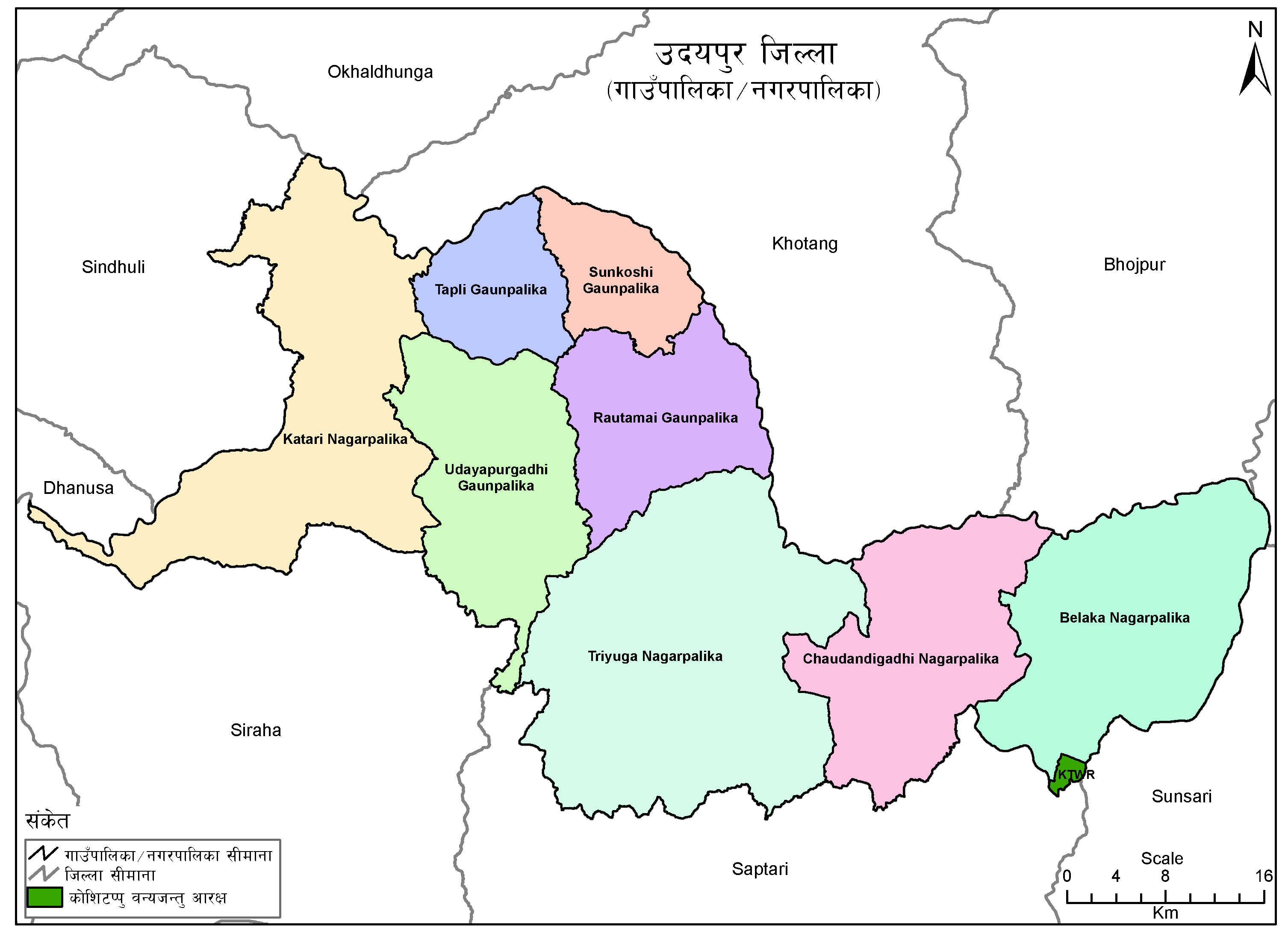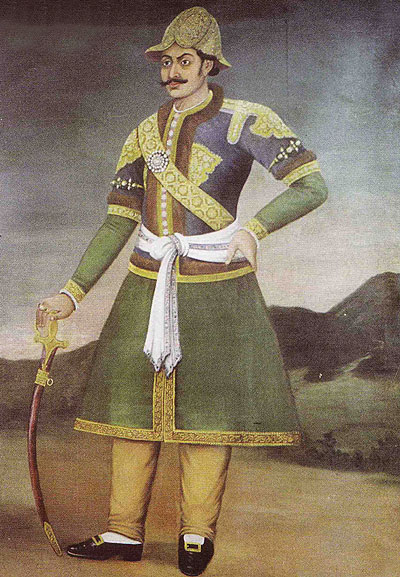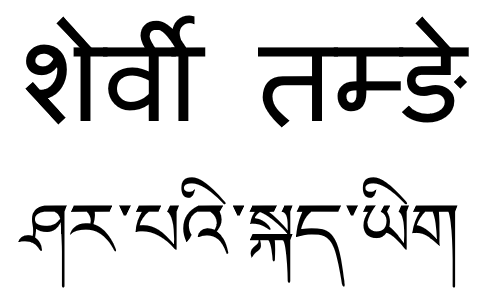|
Udayapurgadhi
Udayapurgadhi Rural Municipality () is a rural municipality in Udayapur District of Koshi Province in Nepal. There are 4 rural municipalities in Udayapur District. There are 8 wards in this municipality. According to 2011 census of Nepal, the total population of the municipality is 30,731 and total area is 269.51 km². The headquarter of the municipality is in Panchawati The rural municipality was established on March 10, 2017 when Ministry of Federal Affairs and Local Development (Nepal), Ministry of Federal Affairs and Local Development dissolved the existing Village development committee (Nepal), village development committees and announced the establishment of this new local body. Panchawati, Bhalayadanda, Tawasri, Dumre and Barre Village development committee (Nepal), VDCs were merged to form the new rural municipality. Demographics At the time of the 2011 Nepal census, Udayapurgadhi Rural Municipality had a population of 30,780. Of these, 48.0% spoke Nepali language, N ... [...More Info...] [...Related Items...] OR: [Wikipedia] [Google] [Baidu] |
Udayapur District
Udayapur District (, is one of the 14 districts of Koshi Province in eastern Nepal. The district, with Triyuga as its district headquarters, covers an area of and in 2001 had a population of 287,689, in 2011 of 317,532, in 2021 of 342,773 Rivers and hills form natural borders for Udayapur District. The Koshi River to the east separates it from Sunsari District and the Sun Kosi River to the north separates it from Bhojpur and Khotang Districts. The Tawa Khola separates it from Sindhuli District to the west and the Siwalik foothills to the south separate it from the outer Tarai of Siraha and Saptari. The Koshi Tappu Wildlife Reserve lies to the east in Udayapur, Sunsari and Saptari Districts. According to the former administrative divisions of Nepal, Udayapur falls in Eastern Development Region in Sagarmatha Zone. History Before the unification of modern Nepal by Shah kings. Udayapur District was under Sen dynasty. The Kingdom name was Chaudandi and capital of the K ... [...More Info...] [...Related Items...] OR: [Wikipedia] [Google] [Baidu] |
Panchawati
Panchawati is a village in, and headquarter of, Udayapurgadhi rural municipality in Udayapur District in Province No. 1 of south-eastern Nepal. At the time of the 1991 Nepal census it had a population of 6,580 people living in 1223 individual households. Panchawati was a village development committee before 2015. In 2015, when Nepal became a federal state, a total of 744 local administrative units were established. 8 such units were established in Udayapur District, including Udayapurgadhi. Panchawati was merged into Udayapurgadhi and established as its headquarter. Udayapurgadhi was previously Headquarter of Udayapur District Udayapur District (, is one of the 14 districts of Koshi Province in eastern Nepal. The district, with Triyuga as its district headquarters, covers an area of and in 2001 had a population of 287,689, in 2011 of 317,532, in 2021 of 342,773 Rive ... before 1972, when the headquarter was moved to Gaighat. References External linksUN map of the munic ... [...More Info...] [...Related Items...] OR: [Wikipedia] [Google] [Baidu] |
Gaunpalika
A gaunpalika ( ) is an administrative division in Nepal. The Ministry of Federal Affairs and Local Development (Nepal), Ministry of Federal Affairs and Local Development dissolved the existing Village development committee (Nepal), village development committees and announced the establishment of this new local body. It is a sub-unit of a List of districts of Nepal, district. There are currently 481 rural municipalities. History The village development committee (Nepal), village development committee was the previous governing body of villages in Nepal. They were replaced on 10 May 2017 by the rural municipalities which were formed by combining different VDCs. The decision was taken by the Council of Ministers of Nepal, cabinet of Nepal after modifications in the report proposed by the Local Level Restructuring Commission. Initially 481 rural municipalities were formed but it was later changed to 481 municipalities. According to the Ministry of Federal Affairs and Local Development ... [...More Info...] [...Related Items...] OR: [Wikipedia] [Google] [Baidu] |
Nepali Language
Nepali (; , ), or ''Gorkhali'' is an Indo-Aryan languages, Indo-Aryan language native to the Himalayas region of South Asia. It is the official and most widely spoken Languages of Nepal, language of Nepal, where it also serves as a ''lingua franca''. Nepali has Languages with official status in India, official status in the Indian state of Sikkim and in the Gorkhaland Territorial Administration of West Bengal. It is spoken by about a quarter of Bhutan's population. Nepali also has a significant number of speakers in the Indian states of Arunachal Pradesh, Assam, Himachal Pradesh, Manipur, Meghalaya, Mizoram and Uttarakhand. In Myanmar it is spoken by the Burmese Gurkhas. The Nepali diaspora in the Middle East, Brunei, Australia and worldwide also use the language. Nepali is spoken by approximately 19 million native speakers and another 14 million as a second language. Nepali is commonly classified within the Eastern Pahari group of the Northern Indo-Aryan languages, Northern zo ... [...More Info...] [...Related Items...] OR: [Wikipedia] [Google] [Baidu] |
Chhetri
Chhetri (Kshetri, Kshettri, Kshetry or Chhettri), ( ; IAST: ''Kṣetrī'') historically called Kshettriya or Kshetriya or Khas are Nepali language, Nepali speaking people historically associated with the warrior class and administration, some of whom trace their origin to migration from medieval India. Chhetri was a caste of administrators, governors, Bir Bhadra Thapa, warriors and military elites in the medieval Khasa kingdom, Khas Kingdom and Gorkha Kingdom (later unified Kingdom of Nepal). The nobility of the Gorkha Kingdom mainly originated from Chhetri families. They also had a strong presence in civil administration affairs. The bulk of Prime Minister of Nepal, prime ministers of Nepal before the Revolution of 1951, democratization of Nepal belonged to this caste as a result of the old Gorkhali aristocracy. Gorkha-based aristocratic Chhetri families included the Pande dynasty, the Basnyat dynasty, the Kunwar family (and their offspring branch, the autocratic Rana dynasty) an ... [...More Info...] [...Related Items...] OR: [Wikipedia] [Google] [Baidu] |
Tamang People
The Tamang people (; Devanagari: तामाङ; ''tāmāṅ'') are an ethnic group living in Nepal, Northeast India and southern Bhutan. In Nepal, they are concentrated in the central hilly and Himalayan regions and constituted over 1.6 million people in the 2021 census. In India, Tamang people live in the state of Sikkim, in the Darjeeling district, Darjeeling and Kalimpong districts of West Bengal and in Assam. In Bhutan, they live foremost in the southern foothills including Tsirang District, Dagana District, Samtse District, Chukha District, Sarpang District and Samdrup Jongkhar District. The Tamang language is the fifth most-spoken language in Nepal. History Research indicates that the Tamang people are a hybrid ethnic group with an estimated 59% genetic contribution from Tibetan and 41% from Nepalese ancestries. The Tamangs have been mentioned in various Nepalese and colonial historical records under a variety of names, such as ''Bhote'', ''Bodh'', ''Lama'', ''Murmi' ... [...More Info...] [...Related Items...] OR: [Wikipedia] [Google] [Baidu] |
Magars
The Magars, also spelled Mangar and Mongar, are the largest ethnic group native to Nepal and Northeast India, representing 6.9% of Nepal's total population according to the 2021 Nepal census. They are one of the main Gurkha tribes. The first home of the Magars was to the west of the Gandaki River and, roughly speaking, consisted of that portion of Nepal which lies between and around about Gulmi District, Gulmi, Arghakhanchi District, Arghakhanchi, and Palpa District, Palpa. This part of the country was divided into twelve districts known as ''Bahra Magarat'' (Confederation of Twelve Magar villages), which included the following regions of that period: Argha, Arghakhanchi District, Khanchi, Bhirkot, Dhor, Garhung, Ghiring, Gulmi, Isma, Musikot, Rising, Satungal, Satung, and Pyung. During the medieval period, the whole area from Palpa District, Palpa to Rukum Rolpa was called the Magarat, a place settled and inhabited by Magars. Another confederation of eighteen Magar kingdoms, k ... [...More Info...] [...Related Items...] OR: [Wikipedia] [Google] [Baidu] |
Wambule Language
Wambule (; ) is a Kiranti language language spoken by the Wambule Rai, one of the Rai groups belonging to the Kiranti (किरान्ती) ethnolinguistic family of eastern Nepal. Wambule is spoken by more than 5000 people living around the confluence of the Sunkosi (सुनकोसी) and Dudhkosi (दूधकोसी) rivers near Kui-Bhir Hill. The Wambule-speaking area comprises the southernmost part of Okhaldhunga district, the westernmost part of Khotang district, the northernmost part of Udayapur district, and the northeasternmost part of Sindhuli district. Names ''Ethnologue'' records numerous other names that are used for this language. They include Umbule (उँबुले), Ambule, Awambule (अ्वाम्बुले), Caurasia, Chaurasia, Chaurasya, Chourase, Chourasia, Ombule, Radu Yor./Ayor, Tsaurasya, Umbule, Vambucauras Raduyor/Raduayor, Vambule, Vambule Radu Yor/Ayor, and Vambule Yor/Ayor. The Wambule use several native and Nepali names to d ... [...More Info...] [...Related Items...] OR: [Wikipedia] [Google] [Baidu] |
Sunwar Language
Sunuwar, or Koinch (; ; other spellings are Koinch and Koincha), is a Kiranti language of the Sino-Tibetan language family spoken in Nepal and India by the Sunuwar people. It was first comprehensively attested by the Himalayan Languages Project. It is also known as Kõits Lo ( ; ), Kiranti-Kõits ( ; ), and Mukhiya ( ; ). The Sunuwar language is one of the smaller members of the Tibeto-Burman language family. About 40,000 speakers are residing in eastern Nepal. Names The language is commonly known as ''Koic,'' for many ethnic Sunuwar speakers also refer to the language as “''Sunuwar, Koinch'' '', Koinch'' or ''Koincha'' (कोइँच); ''Kõits Lo'' (कोइँच लो), ''Kiranti-Kõits'' (किराँती-कोइँच) or ''Mukhiya'' (मुखिया).” Moreover, most Sunwar speakers have the surname (सुनुवार), ''Sunuvār'' in Latin script. Geographic distribution The Sunuwar language is commonly spoken in a cluster of Sunuwar ... [...More Info...] [...Related Items...] OR: [Wikipedia] [Google] [Baidu] |
Sherpa Language
Sherpa (also Sharpa, Sherwa, or Xiaerba) is a Tibetic language spoken in Nepal and the Indian state of Sikkim, mainly by the Sherpa. The majority speakers of the Sherpa language live in the Khumbu region of Nepal, spanning from the Chinese (Tibetan) border in the east to the Bhotekosi River in the west. About 127,000 speakers live in Nepal (2021 census), some 16,000 in Sikkim, India (2011), and some 800 in the Tibetan Autonomous Region (1994). Sherpa is a subject-object-verb (SOV) language. Sherpa is predominantly a spoken language, although it is occasionally written using either the Devanagari or Tibetan script. Classification Sherpa belongs to the Tibetic branch of the Tibeto-Burman family. It is closely related to Central Tibetan, Jirel, Humla, Mugom, Dolpo, Lo-ke, Nubri, Tsum, Langtang, Kyirong, Yolmo, Gyalsumdo, Kagate, Lhomi, Walung, and Tokpe Gola. Literary Tibetan ''LT''- becomes /lh/ and ''SR-'' becomes /ʈ/. There are five closely related dialect ... [...More Info...] [...Related Items...] OR: [Wikipedia] [Google] [Baidu] |
Maithili Language
Maithili ( , ) is an Indo-Aryan language spoken in parts of India and Nepal. It is native to the Mithila region, which encompasses parts of the eastern Indian states of Bihar and Jharkhand as well as Nepal's Koshi Province, Koshi and Madhesh Provinces. It is one of the 22 scheduled languages of India. It is the second most commonly spoken native languages of Nepal, Nepalese language constitutionally registered as one of the fourteen provincial official languages of Nepal. It is spoken by 21.7 million people. Of those, 3.2 million are Nepalis, Nepalese speakers. The language is predominantly written in Devanagari, but the historical Tirhuta script, Tirhuta and Kaithi scripts retained some use until today. Official status In 2003, Maithili was included in the 8th Schedule, Eighth Schedule of the Indian Constitution as a recognised language of India, Indian language, which allows it to be used in education, government, and other official contexts in India. The Maithili language i ... [...More Info...] [...Related Items...] OR: [Wikipedia] [Google] [Baidu] |
Newar People
Newar (; , endonym: Newa; , Pracalit script: ), or Nepami, are primarily inhabitants in Kathmandu Valley of Nepal and its surrounding areas, and the creators of its historic heritage and civilisation. Page 15. Newars are a distinct linguistic and cultural group, primarily Indo-Aryan peoples, Indo-Aryan and Tibeto-Burman migration to Indian subcontinent, Tibeto-Burman ethnicities, who share a common language, Newar language, Nepal Bhasa, and predominantly practice Newar Hinduism and Newar Buddhism. Newars have developed a division of labour and a sophisticated urban civilisation not seen elsewhere in the Himalayas, Himalayan foothills. Newars have continued their age-old traditions and practices and pride themselves as the true custodians of the religion, culture and civilisation of Nepal. Newars are known for their contributions to culture, Newa art, art and Newari literature, literature, Lhasa Newar, trade, Agriculture in Nepal, agriculture and Newa cuisine, cuisine. Today, th ... [...More Info...] [...Related Items...] OR: [Wikipedia] [Google] [Baidu] |




